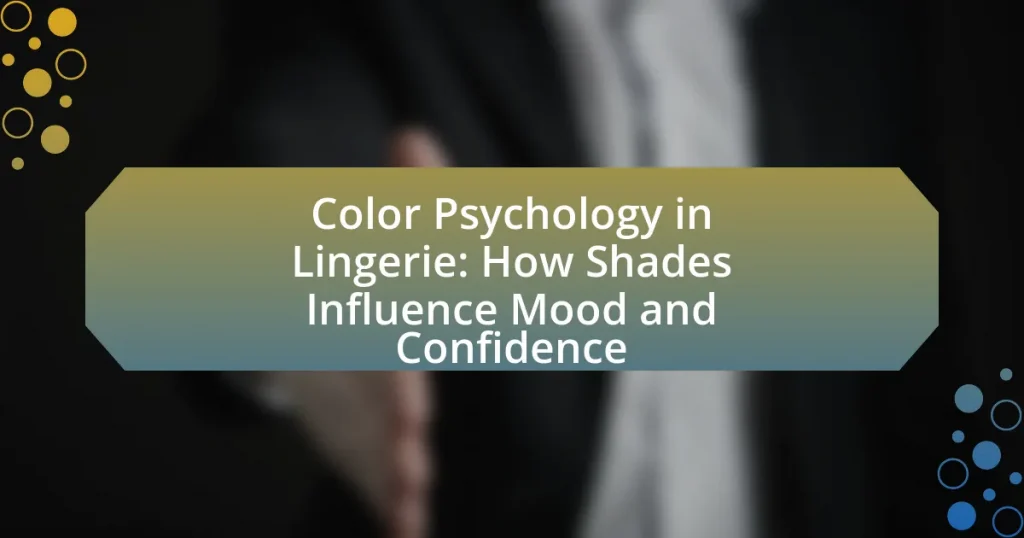Color psychology in lingerie examines how different colors affect emotions, perceptions, and behaviors related to intimate apparel. Each color, such as red for passion and black for sophistication, can influence mood and self-esteem, impacting how individuals feel in their lingerie. The article explores the psychological effects of various colors, cultural influences on color perception, and the significance of color choices in enhancing confidence and personal expression. Additionally, it provides practical tips for selecting lingerie colors that align with desired emotional states and improve shopping experiences. Understanding these concepts can empower individuals to make informed decisions that enhance their overall confidence and emotional well-being.

What is Color Psychology in Lingerie?
Color psychology in lingerie refers to the study of how different colors influence emotions, perceptions, and behaviors related to intimate apparel. Each color evokes specific feelings; for example, red is often associated with passion and desire, while black conveys sophistication and mystery. Research indicates that colors can significantly impact mood and confidence levels, with studies showing that wearing certain colors can enhance self-esteem and attractiveness. For instance, a study published in the Journal of Experimental Psychology found that individuals wearing red were perceived as more attractive and confident. Thus, understanding color psychology in lingerie can help individuals choose pieces that align with their desired emotional state and social interactions.
How does color influence emotions and perceptions in lingerie?
Color significantly influences emotions and perceptions in lingerie by evoking specific feelings and associations. For instance, red is often linked to passion and desire, making it a popular choice for romantic occasions, while black is associated with sophistication and elegance, enhancing a sense of allure. Research indicates that colors can affect mood; a study published in the Journal of Experimental Psychology found that warm colors like red and orange can increase arousal, while cool colors like blue and green tend to have a calming effect. Additionally, the choice of color in lingerie can impact self-perception and confidence, as individuals may feel more empowered or attractive in certain shades, reinforcing the psychological connection between color and emotional response.
What are the psychological effects of different colors?
Different colors evoke specific psychological effects that can influence mood and behavior. For instance, red is often associated with passion and energy, stimulating excitement and increasing heart rates. Blue tends to promote calmness and tranquility, often linked to feelings of serenity and stability. Yellow is associated with happiness and optimism, as it can stimulate mental activity and generate feelings of cheerfulness. Green is connected to nature and balance, fostering a sense of relaxation and renewal. Purple is often linked to luxury and creativity, inspiring imagination and introspection. These associations are supported by various studies, including research published in the journal “Color Research and Application,” which highlights how color perception can significantly affect emotional responses and decision-making processes.
How do cultural factors affect color perception in lingerie?
Cultural factors significantly influence color perception in lingerie by shaping the meanings and associations attached to specific colors. For instance, in Western cultures, red often symbolizes passion and desire, making it a popular choice for lingerie, while in some Asian cultures, red is associated with good fortune and celebration, leading to its use in bridal lingerie. Additionally, the perception of colors like white can vary; in Western societies, it represents purity and innocence, whereas in some Eastern cultures, it is linked to mourning. These cultural interpretations affect consumer preferences and purchasing decisions, as individuals are likely to choose lingerie colors that resonate with their cultural values and beliefs.
Why is understanding color psychology important for lingerie choices?
Understanding color psychology is important for lingerie choices because colors evoke specific emotions and can influence mood and confidence. For instance, studies show that red is associated with passion and attraction, while black conveys sophistication and elegance. Choosing the right color can enhance personal expression and impact how individuals feel in their lingerie, ultimately affecting their confidence levels. Research indicates that colors can trigger psychological responses; for example, a survey by the Pantone Color Institute found that 84% of consumers make decisions based on color alone. Therefore, understanding these associations helps individuals select lingerie that aligns with their desired emotional state and enhances their overall experience.
How can color choices enhance confidence and mood?
Color choices can enhance confidence and mood by influencing psychological and emotional responses. For instance, studies show that colors like red can evoke feelings of power and confidence, while blue is often associated with calmness and stability. Research published in the journal “Color Research and Application” indicates that individuals wearing colors that align with their desired emotional state report higher levels of confidence and improved mood. This connection between color and emotional response is rooted in cultural associations and personal experiences, making color selection a powerful tool in enhancing self-perception and emotional well-being.
What role does color play in personal expression through lingerie?
Color plays a significant role in personal expression through lingerie by influencing emotions and self-perception. Different colors evoke specific feelings; for instance, red is often associated with passion and confidence, while black can signify elegance and mystery. Research indicates that color can affect mood and behavior, as demonstrated in a study published in the journal “Color Research and Application,” which found that colors can impact psychological responses and social interactions. Therefore, the choice of color in lingerie not only reflects personal style but also enhances the wearer’s emotional state and confidence.

What are the common colors used in lingerie and their meanings?
Common colors used in lingerie include black, white, red, blue, and pink, each carrying distinct meanings. Black symbolizes sophistication and power, often associated with seduction. White represents purity and innocence, frequently chosen for bridal lingerie. Red conveys passion and desire, making it a popular choice for romantic occasions. Blue is linked to calmness and trust, while pink signifies femininity and playfulness. These associations are rooted in color psychology, which suggests that colors can influence emotions and perceptions, thereby affecting confidence and mood.
What emotions are associated with popular lingerie colors?
Popular lingerie colors are associated with specific emotions that influence mood and confidence. For example, red is often linked to passion and desire, evoking feelings of excitement and romance. Black is associated with sophistication and mystery, instilling a sense of confidence and allure. White symbolizes purity and innocence, often evoking feelings of freshness and simplicity. Pink is connected to love and tenderness, promoting feelings of warmth and affection. Blue is associated with calmness and tranquility, fostering a sense of peace and relaxation. These associations are supported by color psychology research, which indicates that colors can significantly impact emotional responses and perceptions.
How does red lingerie influence attraction and passion?
Red lingerie significantly enhances attraction and passion due to its association with love, desire, and confidence. The color red is often linked to heightened emotions and can stimulate feelings of excitement and arousal. Research indicates that red can increase heart rates and evoke strong emotional responses, making it a powerful color choice in intimate settings. A study published in the Journal of Experimental Psychology found that individuals wearing red are perceived as more attractive and sexually desirable, reinforcing the idea that red lingerie can amplify romantic interest and passion.
What feelings does black lingerie evoke in terms of elegance and mystery?
Black lingerie evokes feelings of sophistication and allure, primarily due to its association with elegance and mystery. The color black is often linked to power, authority, and timelessness, which enhances the perception of elegance. Additionally, black lingerie creates an air of intrigue, as it can suggest hidden depths and secrets, contributing to a sense of mystery. This duality is supported by color psychology, which indicates that darker shades can evoke stronger emotional responses, making black a popular choice for intimate apparel. Studies in color psychology highlight that black can enhance confidence and self-assurance, further reinforcing its elegant and mysterious qualities.
How do pastel colors affect mood and confidence in lingerie?
Pastel colors in lingerie positively affect mood and confidence by evoking feelings of calmness and femininity. Research indicates that soft hues like lavender, mint green, and blush pink are associated with tranquility and warmth, which can enhance emotional well-being. A study published in the Journal of Color Research found that colors influence psychological responses; for instance, pastel shades can reduce anxiety and promote a sense of comfort. This emotional uplift can lead to increased self-esteem and confidence when wearing lingerie in these colors, as individuals often feel more attractive and at ease in softer tones.
What is the significance of pink in lingerie choices?
Pink in lingerie choices signifies femininity, romance, and playfulness. This color is often associated with softness and warmth, which can evoke feelings of comfort and affection. Research indicates that pink can have a calming effect, potentially enhancing mood and boosting confidence in wearers. For instance, a study published in the journal “Color Research and Application” found that colors like pink can influence emotional responses, making it a popular choice for lingerie aimed at promoting intimacy and self-expression.
How do light blue and lavender shades promote calmness?
Light blue and lavender shades promote calmness by evoking feelings of tranquility and serenity. Research indicates that light blue is associated with the sky and water, which are natural elements known to reduce stress and anxiety. Similarly, lavender, a blend of blue and purple, is often linked to relaxation and peace, making it a popular choice in environments designed for rest. Studies have shown that exposure to these colors can lower heart rates and reduce feelings of tension, reinforcing their calming effects.

How can individuals apply color psychology to their lingerie selections?
Individuals can apply color psychology to their lingerie selections by choosing colors that align with their desired emotional states or intentions. For instance, red is often associated with passion and confidence, making it a popular choice for romantic occasions. Blue, on the other hand, conveys calmness and tranquility, which may be preferred for everyday wear. Research indicates that colors can significantly influence mood; for example, a study published in the journal “Color Research and Application” found that warm colors like red and orange can evoke feelings of excitement, while cool colors like blue and green promote relaxation. By understanding these associations, individuals can select lingerie colors that enhance their mood and boost their confidence.
What strategies can be used to choose lingerie colors that boost confidence?
To choose lingerie colors that boost confidence, individuals should consider their personal preferences, skin tone, and the psychological effects of colors. Personal preferences play a crucial role; selecting colors that resonate with one’s style can enhance self-esteem. Skin tone is also significant; for example, warm skin tones often look better in earthy colors like reds and oranges, while cool skin tones may shine in blues and purples.
Psychological effects of colors further influence confidence; studies show that red is associated with power and passion, while black conveys sophistication and elegance. A survey by the Pantone Color Institute indicates that 85% of consumers make purchasing decisions based on color, highlighting its impact on mood and perception. Therefore, aligning lingerie color choices with these factors can effectively boost confidence.
How can one assess personal color preferences and their meanings?
One can assess personal color preferences and their meanings by reflecting on emotional responses to different colors and utilizing color psychology frameworks. Individuals often have innate reactions to colors based on personal experiences, cultural influences, and psychological associations; for example, blue is frequently linked to calmness, while red may evoke feelings of passion or excitement. Research in color psychology, such as the work by Angela Wright in “The Color Affects System,” indicates that colors can significantly impact mood and behavior, providing a structured approach to understanding personal preferences. By analyzing these emotional connections and applying established color theories, one can gain insights into their color choices and the meanings behind them.
What tips can help in selecting colors for different occasions?
To select colors for different occasions, consider the emotional impact and cultural significance of colors. For instance, red often symbolizes passion and is suitable for romantic events, while blue conveys calmness and is ideal for professional settings. Research indicates that colors can influence mood; for example, a study published in the Journal of Experimental Psychology found that warm colors can evoke feelings of excitement, while cool colors promote relaxation. Additionally, understanding the context of the occasion, such as formal versus casual, can guide color choices effectively.
How can understanding color psychology improve lingerie shopping experiences?
Understanding color psychology can significantly enhance lingerie shopping experiences by influencing consumer emotions and perceptions. For instance, colors like red are often associated with passion and confidence, which can lead shoppers to feel more empowered when selecting lingerie in that hue. Research indicates that colors can evoke specific emotional responses; a study published in the Journal of Experimental Psychology found that warm colors can increase feelings of excitement and energy, while cool colors tend to promote calmness and relaxation. By leveraging this knowledge, retailers can curate collections that align with the emotional states they wish to evoke, ultimately leading to more satisfying shopping experiences and increased sales.
What should consumers consider when shopping for lingerie based on color psychology?
Consumers should consider the emotional and psychological effects of colors when shopping for lingerie, as different shades can evoke specific feelings and influence confidence. For instance, red is often associated with passion and desire, making it a popular choice for romantic occasions, while black conveys sophistication and elegance, often chosen for its slimming effect. Additionally, softer colors like pastels can promote feelings of calmness and comfort, appealing to those seeking a more relaxed vibe. Research indicates that color can significantly impact mood; a study published in the journal “Color Research and Application” found that colors can affect emotional responses and perceptions, reinforcing the importance of color selection in lingerie shopping.
How can retailers use color psychology to enhance customer satisfaction?
Retailers can enhance customer satisfaction by strategically using color psychology to influence emotions and perceptions. For instance, warm colors like red and orange can evoke feelings of excitement and urgency, encouraging impulse purchases, while cooler colors such as blue and green promote calmness and trust, enhancing the shopping experience. Research indicates that 85% of consumers make purchasing decisions based on color, highlighting its significant impact on customer behavior. By aligning color choices with the desired emotional response, retailers can create an inviting atmosphere that resonates with customers, ultimately leading to increased satisfaction and loyalty.
What practical tips can enhance confidence through color choices in lingerie?
Choosing the right colors in lingerie can significantly enhance confidence. For instance, wearing red is associated with passion and power, which can boost self-esteem and assertiveness. Similarly, black is often linked to sophistication and elegance, making it a popular choice for those seeking to feel more confident and alluring.
Additionally, soft colors like pastels can evoke feelings of calmness and comfort, which may help individuals feel more at ease in their own skin. Bright colors, such as yellow or orange, can promote feelings of happiness and energy, contributing to a more positive self-image.
Research in color psychology supports these associations; for example, a study published in the journal “Color Research and Application” highlights how colors can influence emotions and perceptions, reinforcing the idea that specific shades can enhance confidence levels.















